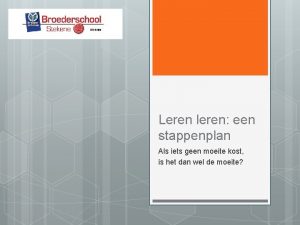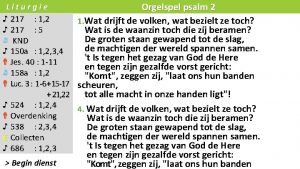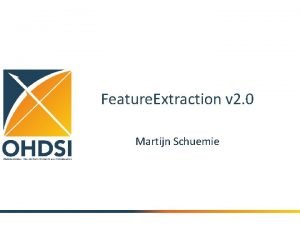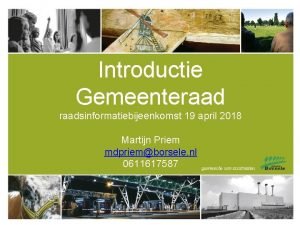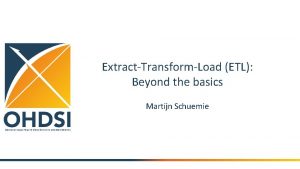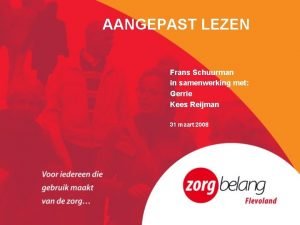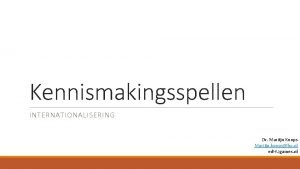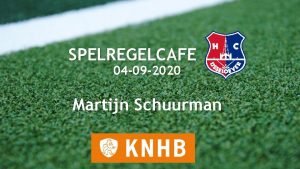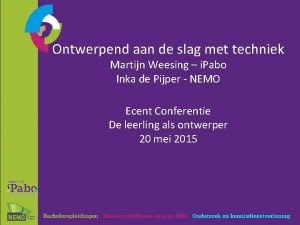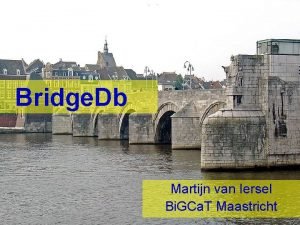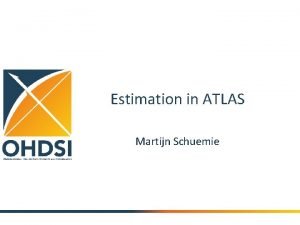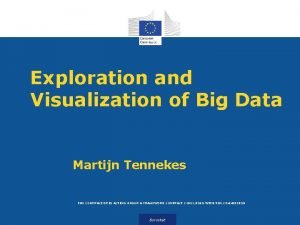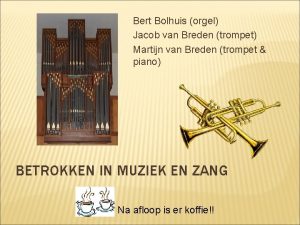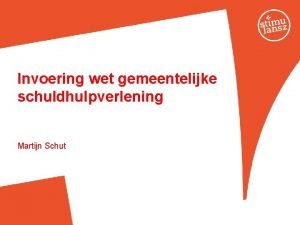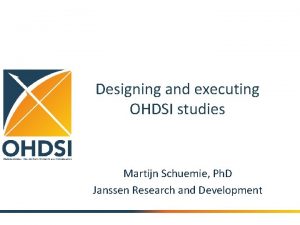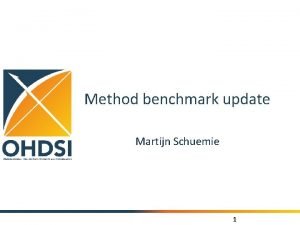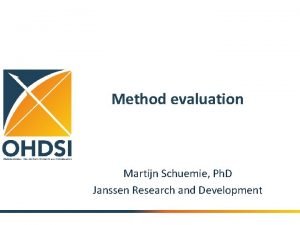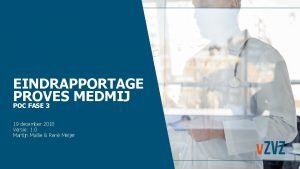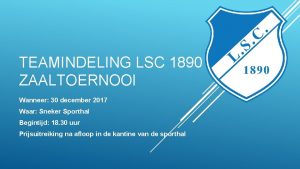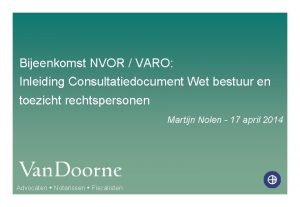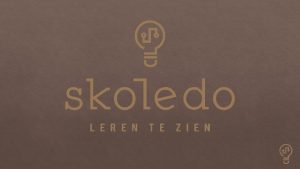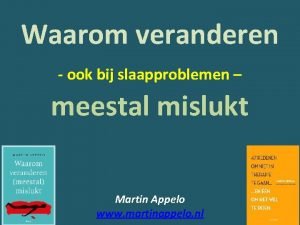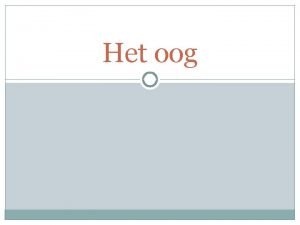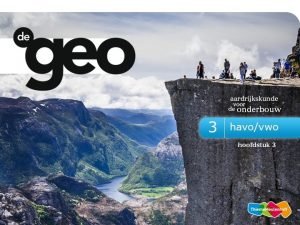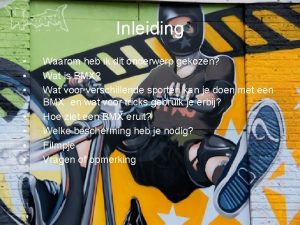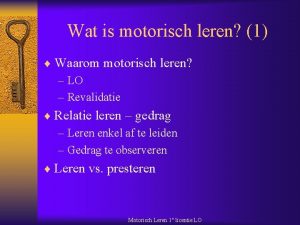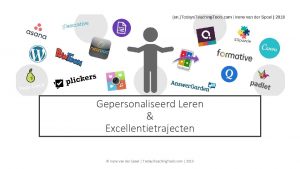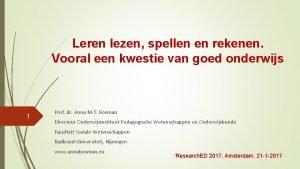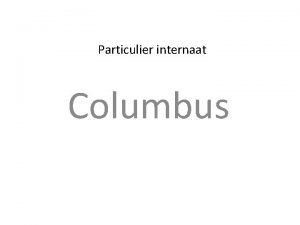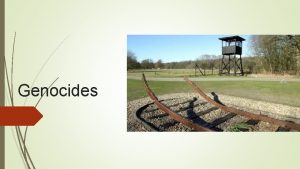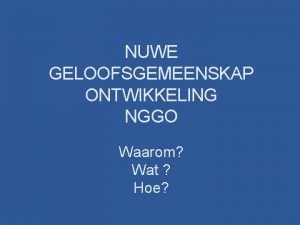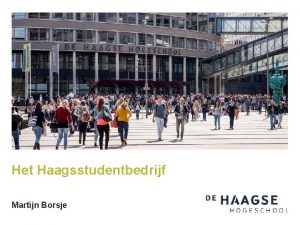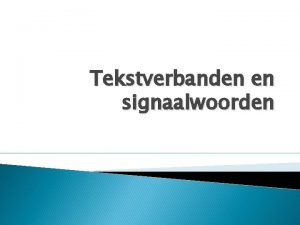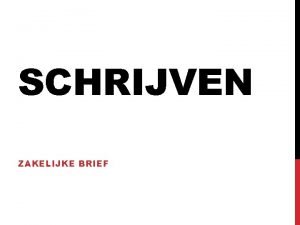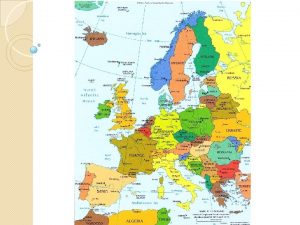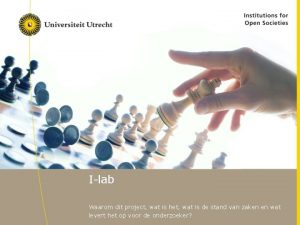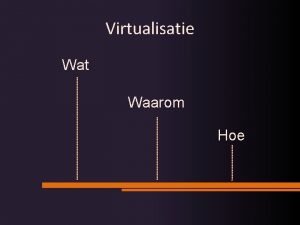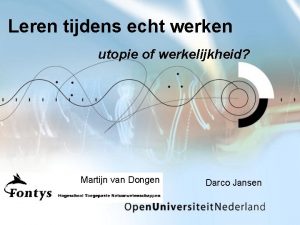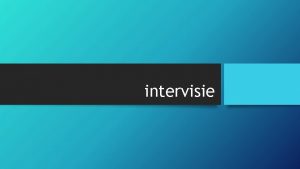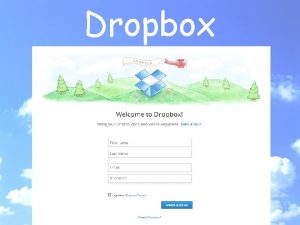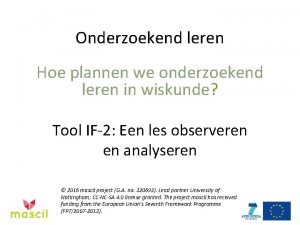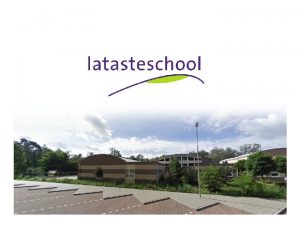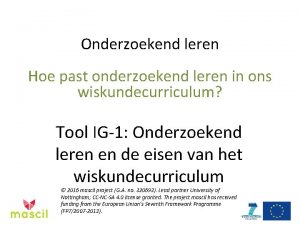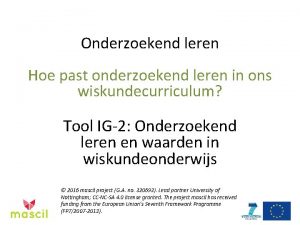Gepersonaliseerd leren wat waarmee en vooral waarom Martijn

































- Slides: 33

Gepersonaliseerd leren: wat, waarmee, en vooral, waarom? Martijn Meeter Dept. of Educ. Science Vrije Universiteit Amsterdam m@meeter. nl www. meeter. nl/m

Waarom gepersonaliseerd, 1 P

Waarom gepersonaliseerd, 2

Waarom gepersonaliseerd, 3

Waarom gepersonaliseerd, 4

Wat gaan we bespreken? 1. Wat is gepersonaliseerd leren? 2. Hoe pakt het uit? 3. Hoe zou ik het doen?

1. WAT IS GEPERSONALISEERD LEREN?

Definities Bray & Mc. Claskey (2012) Personalisatie door de lerende Personalisatie voor de lerende

Gepersonaliseerd leren in NL 5, 0 4, 0 Middelen: A. means for PL, per school A B eigen tempo eigen route (leermiddelen) eigen niveau eigen leerdoelen 3, 0 C D E 2, 0 F 1, 0 at own pace own materials own level of ambition Doelen Meer leren Beter differentieren Betere motivatie eigenaarschap 5, 0 own objectives B. goals for PL, per school 4, 0 A B 3, 0 5, 0 C D D. goals for PL, per occup E 2, 0 others 4, 0 F teachers 1, 0 learn more differentiating 3, 0 more motivated owner

Hoe het kan werken: KED Portal Leerdoelen Coaching Tredevakken / themavakken Leraar • • • Inspiratie coach probleemoplosser

Hoe het kan werken: primair Adaptieve oefensoftware Leerdoelen Leerling zelf a. d. slag Leerkracht • • • structureert controleert probleemoplosser

Hoe het kan werken: Agora Indiv. challenges Gekozen met coach Llngen in stamgroepen Leraar • • • Inspiratie coach probleemoplosser

2. HOE PAKT HET UIT?

Voordelen - theoretisch Gemengde groepen en toch leren op eigen niveau Leren op verschillende snelheid & niveau Keus & eigen verantwoordelijkheid die motiveert Vakken afschaffen Andere vaardigheden, persoonsontwikkeling Anders toetsen leren tijd

Nadelen Leunen op eigen initiatief Leunen op begrijpend lezen Samenwerking ↓ Praten ↓ Spagaat met eindexamen Individualized instruction Computer-assisted instr. Student control of learning Hattie (2007). Visible learning

En wat bereik je? B. implemented goals for PL, per school 4, 0 A B 3, 0 C D 2, 0 E F 1, 0 learn more motivated owner differentiating

Onderzoek • Systeemvergelijkingen • • Brak Leren ↑ Motivatie ↔ Zelfgestuurd leren ↔ • Adaptieve software • Leren ↑ (snappet) • Motivatie ↔ • Keuze in vakken • Leren ↔ • Motivatie ↔

Samenvatting • Gepersonaliseerd leren • Veel vormen, op te delen in personalisatie voor de lerende / personalisatie door de lerende (individualization / personalization) • Voor: keuze, differentiatie, mixen • Tegen: soms inefficient • Voordelen zonder nadelen?

3. EN WAT ZOU IK DOEN?

Hoe het kan werken: KED Portal Leerdoelen Coaching Tredevakken / themavakken Leraar • • • Inspiratie coach probleemoplosser

Middenweg-van-ongetest-materiaal • Talen, wiskunde, aan wiskunde gekoppelde concepten klassikaal, in tracks richting eindexamen • Overige leerdoelen projectmatig (keuze, groepswerk, opbouw projectbibiotheek gekoppeld aan leerdoelen) • Voortgangstoetsen, geen cijfers maar kruisjes Overige leerdoelen frans Taal: NL+Eng wiskunde+ 1 2 … 3 4 5 6

The End Questions? papers: www. meeter. nl/m

What is the solution? 1. Repeat Lesson 2: often a memory is not gone, but you can’t access it with the cues you have 2. Add meaning 23

Semantic memory Memory for facts “what is the capital of Cambodia? ” “what does “capital” mean? ” (episodic memory= events) 24

Semantic memory 25

Semantic and episodic memory Lesson 3: your knowledge decides what becomes active in your working memory 26

What does this mean for the education? Iconic memory Working memory 1 b: guide attention of your students (cognitive load theory) Lesson 1 a: you only remember what you attend to Long term memory

Lesson 2 1. Repeat Lesson 2 a: often a memory is not gone, but you can’t access it with the cues you have 2. Add meaning 2 b: don’t think the students know something after one encounter. Repeat and keep repeating. (spaced repetition; automatization) 28

Lesson 3 3 b: your student does not remember what you said, but what she thought (conceptual change theory) 3 c: make sure your student thinks (elaboration; self-determination theory; in their own words) Lesson 3 a: your knowledge decides what becomes active in your working memory 29

A program Lesson 1 a: you only remember what you attend to 1 b: guide attention of your students : cognitive load theory Lesson 2 a: often a memory is not gone, but you can’t access it with the cues you have 2 b: don’t think the students know something after one encounter. Repeat and keep repeating : spaced repetition, automatization Les 3 a: your knowledge decides what becomes active in your working memory 3 b: your student does not remember what you said, but what she thought: conceptual change theory 3 c: make sure your student thinks : elaboration, self-determination theory, in their own words

Conclusions Educational science is science Replace vision with knowing General conclusions are possible We know already a lot Fundamental lessons about learning fit with fundamental work about education Nevertheless, the are large gaps in knowledge to be filled Relevant papers: see www. meeter. nl/m

Summary • Forgetting from real life • recency • childhood amnesia • memory bump • Truth & memory • memory mirrors experiences • but no so that we can always retell the past: we mix and match experiences – only the aggregate is truthful

Scenario In Utrecht komt een nieuwe woonwijk, met huur- en koophuizen door elkaar van verschillende prijscategorieën. De gemeente Utrecht vraagt jullie om een nieuwe brede VO / MBO-school op te zetten die specifiek gericht is op gepersonaliseerd leren. Jullie zijn het team dat concrete plannen moet maken voor de eerste jaren, waarin een onderbouw wordt gecreëerd. Bedenk hoe jullie de school in gaan richten. Betrek daarbij in ieder geval welke leermiddelen je wilt gebruiken, wat de eisen zijn aan een (te ontwikkelen) volgsysteem, wat de schoolstructuur in grote lijnen is, wat de verdeling is van verantwoordelijkheden tussen individuele leraren, teams van leraren, de ondersteuning en management en in hoeverre de rol van de leraar verandert. En hoe je na twee jaar gaat bepalen dat je school succesvol is. De rapporteur van jullie groepje maakt notities om het voorstel straks te kunnen presenteren aan de andere groep.
 Leren leren stappenplan
Leren leren stappenplan Psalm 217
Psalm 217 Martijn schuemie
Martijn schuemie Martijn priem
Martijn priem Marc suchard
Marc suchard Martijn schuemie
Martijn schuemie Frans schuurman
Frans schuurman Martijn koops
Martijn koops Kahoot
Kahoot Martijn weesing
Martijn weesing Martijn van iersel
Martijn van iersel Ohdsi atlas demo
Ohdsi atlas demo Tableplot
Tableplot Martijn tennekes
Martijn tennekes Martijn van der heide
Martijn van der heide Patrick van wattum
Patrick van wattum Martijn van breden
Martijn van breden Folium
Folium Martijn schut
Martijn schut Martijn schuemie
Martijn schuemie Martijn schuemie
Martijn schuemie Martijn schuemie
Martijn schuemie Martijn mallie
Martijn mallie Martijn corbee
Martijn corbee Martijn burger
Martijn burger Martijn nolen
Martijn nolen Martijn maas
Martijn maas Objectief observeren voorbeelden
Objectief observeren voorbeelden Xy matrix six sigma
Xy matrix six sigma Waarom veranderen meestal mislukt
Waarom veranderen meestal mislukt Personeelsplan
Personeelsplan Waarom rood licht in duikboot
Waarom rood licht in duikboot Waarom heeft chili een unieke ligging
Waarom heeft chili een unieke ligging Waarom heb ik dit onderwerp gekozen
Waarom heb ik dit onderwerp gekozen
